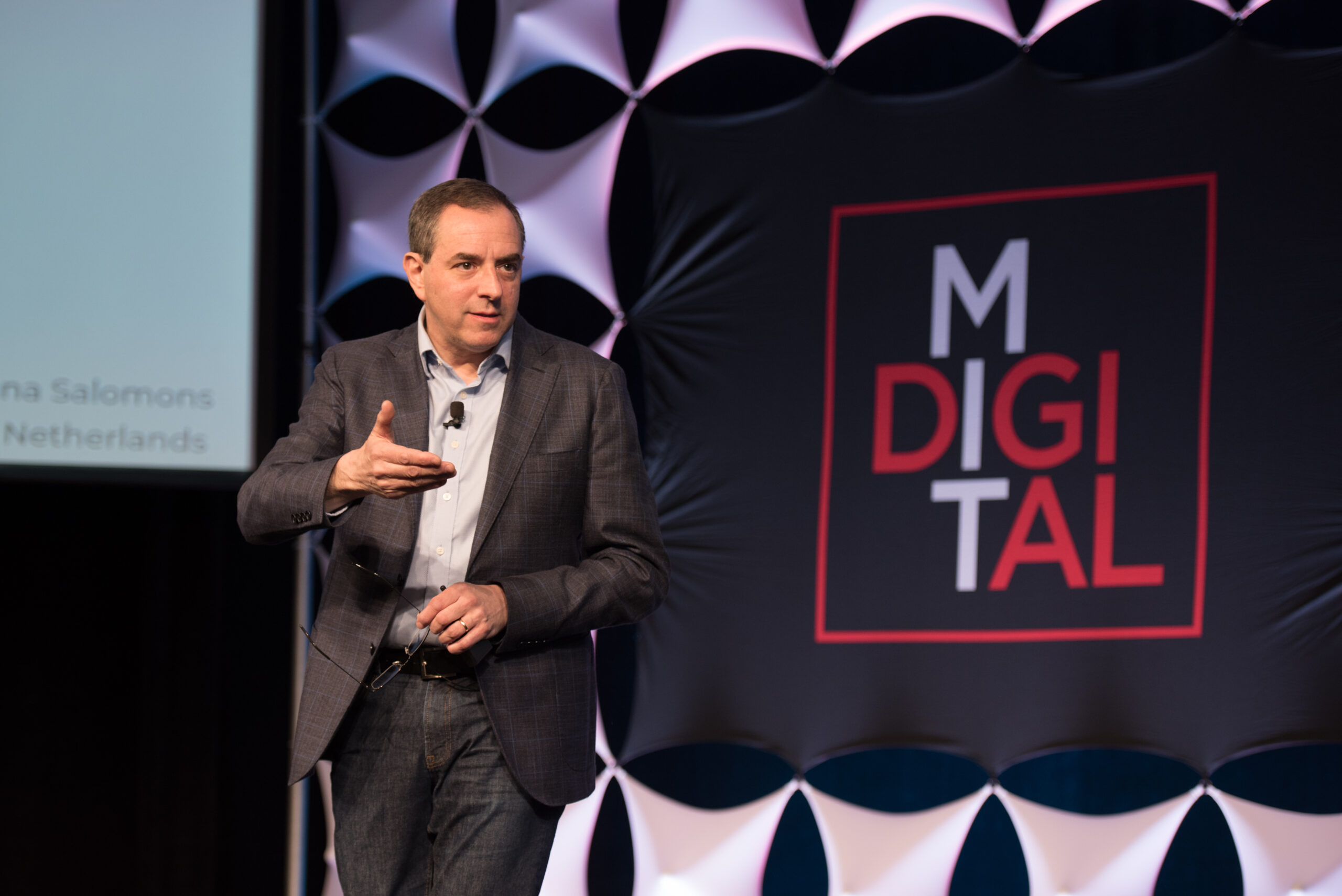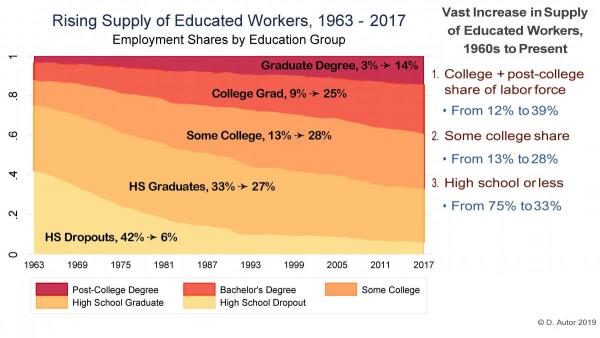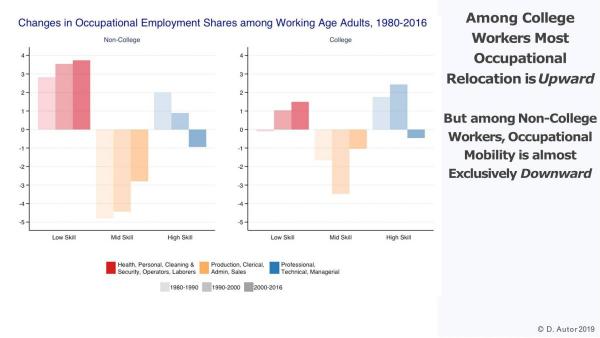
The rise of robots and artificial intelligence (AI) isn’t just reshaping jobs: It’s deciding where work gets done, who gets to do it, and at what wages.
The keynote speaker at this year’s MIT Initiative of the Digital Economy (IDE) annual conference, MIT economist David Autor, presented cutting-edge analysis on this transformation and discussed how opportunities in the job market of the future could be shared more widely.
He began with a puzzle.
You would normally expect the price of something plentiful to go down while the price of scarce things to rise, he said. In fact, the opposite has happened in the American job market over recent decades. Since 1963, the share of the workforce with college or advanced degrees has surged from 12% to 39%, Autor said, while the percent of workers who didn’t finish high school plunged from 42% to just 6% (Figure 1). And yet wages of high-skilled workers have gone up strongly and steadily, while those with few skills have largely seen wages stagnate.


Figure 1
Autor said it’s easier to explain the surge. Rising demand for advanced cognitive skills has meant bigger paychecks for those with degrees, even as their ranks swelled.
It’s harder to explain the fate of low skilled workers, however, and this is where Autor’s research yielded surprising results, some of which he’s still processing and vetting. (Figure 2)


Figure 2
Analyzing Urban Labor Trends
The first surprise is about geography. Autor noted that everyone talks about “superstar cities,” where wages and productivity are growing rapidly. Therefore, he expected to see relatively better opportunity for less-educated workers in these cities than elsewhere. What he found instead was a shift over time, both in terms of the jobs being done by this group and the location of these jobs.
As late as 1970, the mix of jobs done by low skilled workers was different depending on whether they were in a city or in a rural area. Less educated workers in cities tended to include many who held middle-skill jobs in offices and factories, while those outside cities didn’t have those opportunities.
But a sharp change occurred in the 1990s, according to the Autor’s data. The upward mobility that rural workers once experienced as they moved to cities and began working their way into higher paying and more secure middle-skilled jobs—he called it an “occupational escalator”—began to disappear. That makes sense since those jobs also tend to be most easily automated. The data showed that all those workers–whether urban or rural–became increasingly clustered into low-end service jobs instead of middle-skilled jobs.
“Cities have become much more educated, much more skill-intensive, much higher wage places,” said Autor, who also presented these results in the Ely Lecture at the American Economic Association’s annual meeting in January.
What Autor found is a new “bifurcation of work—such that a lot of the role of noncollege workers in urban areas is now basically to see to the care and convenience and maintenance of the affluent, rather than working jointly with them in producing stuff.”
As the occupational structure in urban areas has shifted, so has the wage structure. Autor noted that throughout history, it was good advice for a young person without a college degree to move to a city to find opportunities. But as the work done by these workers in both cities and rural places have become more similar “the wage differential—the compensation for being in a city—is probably just barely enough to cover the cost of living.”
The Need for New Career Paths
Autor then discussed what kind of jobs and careers the economy needs to create to help this group. “We have tons of great careers for the highly educated,” he said. “We have tons of jobs for the less educated. But we have relatively few remaining careers for the less educated.”
He noted the economy creates a steady flow of “frontier jobs,” new fields often tied to technology, such as AI specialists and wind turbine technicians. Another category that he calls “wealth work” consists of occupations that don’t have an obvious technological component but are associated with the consumption habits of high-income workers. Those include jobs like gift wrappers, horse exercisers, “and the ever-popular oyster preparer.”
A third category, he listed, is “last-mile jobs,” which are tasks that were once robust, but have been whittled down by automation, like working in an Amazon warehouse.
The challenge, according to Autor, is creating jobs in any of these categories that can offer secure careers for low-skilled workers. Some tailwinds are working in our favor, he added. Demographic changes mean that there will be fewer young people in the future, which will mean wages will rise for people who can do any kind of dexterity work. In addition, education levels will continue rising, which should also make it harder to get young people to those “wealth” or other service jobs without paying them more.
Addressing the challenges will take time. Asked, for instance, how he expects the political backlash on this issue to be resolved, Autor responded that we’ve figured out how to share the benefits of technological change in the past, and we need to do so again.
Tim Aeppel is a Research Affiliate at the MIT IDE and an economics reporter for Reuters.
